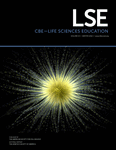Step by Step: Biology Undergraduates’ Problem-Solving Procedures during Multiple-Choice Assessment
Abstract
This study uses the theoretical framework of domain-specific problem solving to explore the procedures students use to solve multiple-choice problems about biology concepts. We designed several multiple-choice problems and administered them on four exams. We trained students to produce written descriptions of how they solved the problem, and this allowed us to systematically investigate their problem-solving procedures. We identified a range of procedures and organized them as domain general, domain specific, or hybrid. We also identified domain-general and domain-specific errors made by students during problem solving. We found that students use domain-general and hybrid procedures more frequently when solving lower-order problems than higher-order problems, while they use domain-specific procedures more frequently when solving higher-order problems. Additionally, the more domain-specific procedures students used, the higher the likelihood that they would answer the problem correctly, up to five procedures. However, if students used just one domain-general procedure, they were as likely to answer the problem correctly as if they had used two to five domain-general procedures. Our findings provide a categorization scheme and framework for additional research on biology problem solving and suggest several important implications for researchers and instructors.



